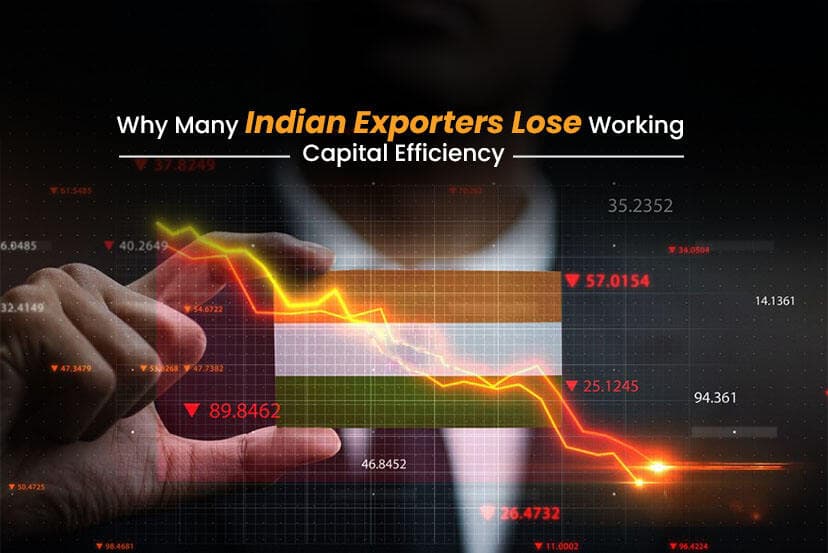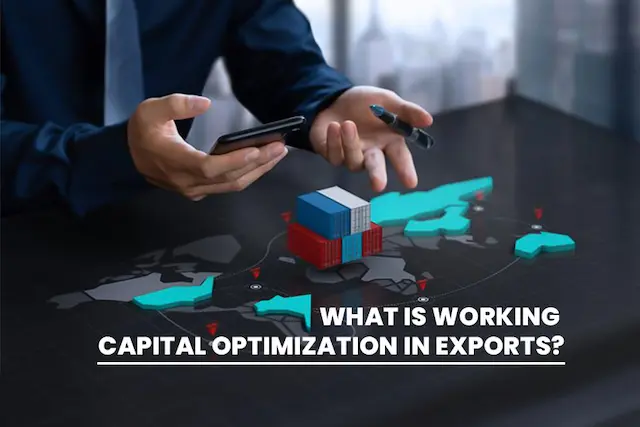Many Indian exporters are having trouble growing or becoming profitable, even with significant demand around the world, due to inefficient working capital management. This can mean that, for companies competing for business in a low-margin, competitive global market, the loss of their working capital efficiency can quickly turn even strong sales into long-term cash flow problems. Improving working capital efficiency is not only a matter of survival, but it is also a fundamental component of sustainable export growth and global competitiveness.
Understanding Working Capital Efficiency for Indian Exporters
Working capital refers to the funds that are tied up while allocating money to support the day-to-day operations of a business. This can include raw materials, stock, wages, and shipping until buyers send payments. Efficiency in the working capital context means reducing the time during which a company faces cash outflows (payments) and cash inflows (collections). This is known as the working capital cycle or cash conversion cycle (CCC).
Exporters can encounter several issues if they are not efficiently managing their working capital cycle:
- Regular liquidity shortages.
- Inability to take larger orders due to a lack of capital.
- Increased reliance on expensive loans and late supplier payments.
- Disruption to the supply chain and loss of global opportunities.
Major Reasons for Indian Exporters’ Working Capital Inefficiency
Knowing the key reasons for working capital inefficiency can help formulate specific corrective responses. The key reasons include:
Prolonged Receivables and Payment Delays
- Exporters face lengthy payment timelines that, due to the nature of international buyers, it is often 30-90 days post-shipment date to receive payment.
- High levels of outstanding invoices extend the cycle around transferring that capital to new orders.
- Continued cash flow extension means more dependence on potentially costly short-term financing that significantly compounds your overall operating costs.
Regulatory, Compliance, and Market Risks
- Processing delays of your GST refund, ambiguous information around shipping or customs, and new or changed global compliance standards can all tie up your capital for weeks and months.
- Shifting trade policies, evolving compliance norms, and currency volatility add uncertainty and can unpredictably stretch cash flow cycles.
- The regulatory and market-level volatility can create unexpected capital lock-ins that are detrimental to improving working capital efficiency.
Over-Stocking and Inventory Pileups
- A significant fear of delays in shipments causes numerous exporters to keep excess raw materials and finished goods.
- Inventory holding costs, accommodations, insurance, and the potential for obsolescence can quickly erode margins.
- A lack of forecast demand leads to excess inventory and locked-up capital.
Tight Supplier Credit and High Upfront Costs
- Many suppliers may require quicker or upfront payments, especially for input materials with high demand.
- Exporters pay suppliers much before they receive revenue from overseas buyers, draining liquidity.
- This strain can result in delays in paying secondary suppliers with high delivery reliability threats.
Inefficient Use of Digital and Process Tools
- Many exporters continue to manually process invoices, payments, and documentation, and the result is more errors and extended cash cycles.
- This results in increasing delays due to paperwork being lost or wrong, and less efficient cash conversion cycles.
- Furthermore, a lack of real-time data limits working capital optimization and creates blind spots for their managers.
Limited Access to Affordable Export Finance
- Only 28.5% of India’s huge $284 billion export finance demand is financed through formal finance, making a huge gap for export users, particularly due to MSME size.
- Collateral-heavy and slow loan processes impede smaller firms from responding to new or large orders.
- Factoring and supply chain finance solutions are under-penetrated, especially outside of large cities.
Actionable Solutions to Improve Working Capital Efficiency
Exporters can achieve better working capital by using process efficiencies, technology, and smart financial tools. Below are some suggestions to improve working capital management:
1. Shorten the Working Capital Cycle
- Accounts Receivable Administration: Consider offering incentives for early payments, enforcing your credit terms strictly, and automating reminder follow-ups when invoices are overdue.
- Speed Up Invoicing: Invoices should be sent with shipments, and there should be a fast follow-up with your buyers to confirm payment.
- Digitize Collections: Utilize e-invoicing and payment portal integrations to reduce payment delays.
2. Optimize Inventory
- Use Just-in-time (JIT) Procurement Processes: Purchase materials when they align with order schedules, so you do not create unnecessary stock.
- Use Forecasting Software for Sales and Demand: Utilize technology that can accurately forecast both quantity & timing for orders and inventory purchases.
- Regular Reviews: Monthly inventory audits allow for the identification of slow-moving stock, allowing for appropriate action to liquidate stock.
3. Strengthen Supplier Negotiation and Terms
- Secure Favorable Supplier Terms: Foster relationships for the best (longer) payment terms with suppliers relative to your ordering cycles.
- Prepare and Plan Buying: Use order size or seasonality to your advantage for more suitable contract terms and settling in advance.
4. Expand Access to Export Finance and Supply Chain Financing
- Embrace Factoring and Invoice Discounting: Tap into platforms and fintechs to liquidate receivables for instant funds with no new collateral.
- Check Out Supply Chain Financing Platforms: Access financing based on the buyer’s creditworthiness with minimal paperwork and low costs.
5. Digitize and Automate Working Capital Processes
- Combine ERP Systems: Use a combination of sales, inventory, and finance data for more intelligent real-time cash flow management.
- Automate Documents: Use digital platforms for compliance, customs, and GST documentation to mitigate delays and mistakes.
The Credlix Approach to Seamless Working Capital Management in India
Exporters experiencing liquidity pressures, slow collections, or pressure from suppliers for payables can find structural relief and new growth opportunities with fintech leaders like Credlix. Working with it allows Indian exporters to transition from working through cash-crunch cycles to sustainable profit-driven growth, converting working capital from a limitation to a method of competitive advantage and resulting in better working capital optimization.
Turning Inefficiency Into Export Opportunity
By integrating disciplined process management, sophisticated digital tools, smart finance options, and platforms like Credlix, exporters can achieve faster growth and liquidity and real global competitiveness. Keep your capital agile, your orders growing, and your risks managed, because when it comes to export, working capital efficiency is not just a measure but a springboard to success globally.
Unlock faster cash management and increase your export growth. [Apply Now for Export Financing Tailored to Your Business]
Frequently Asked Questions
Q1: What challenges do individuals face in improving working capital efficiency?
The most prevalent issues are late payments, excessive inventory, lenders requiring excessive collateral, and bottlenecks in manual processes.
Q2: How can exporters access working capital finance without too much collateral?
There are quite a few finance options available to exporters that take into consideration invoices and/or future expected receivables, via invoice discounting, factoring, and supply chain finance platforms, that either do not require collateral or offer favorable terms.
Q3: Do digital tools help with working capital efficiency?
Yes. Digital platforms automate and provide a well-structured dashboard that can improve your speed of collection and inventory planning, and enable visibility.





